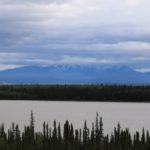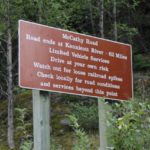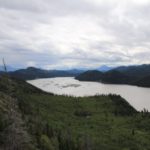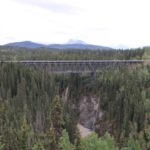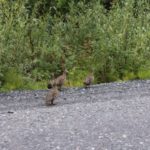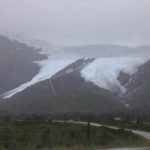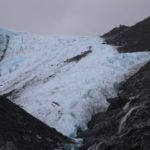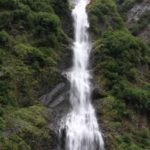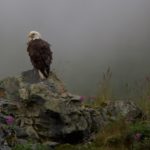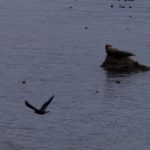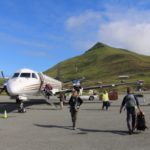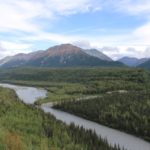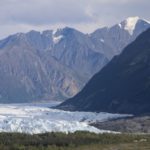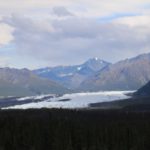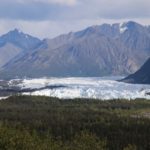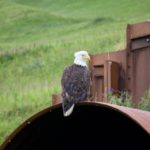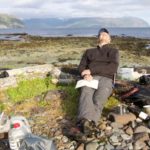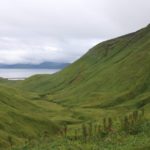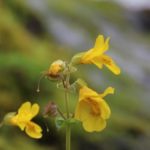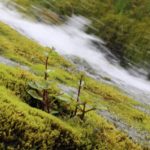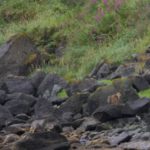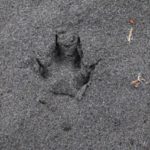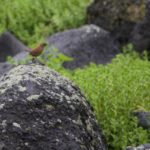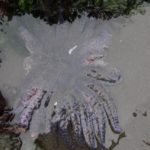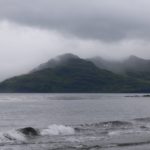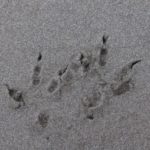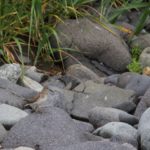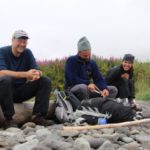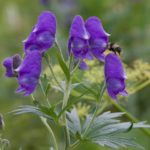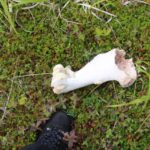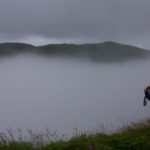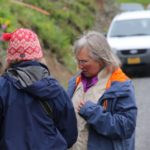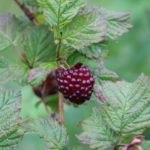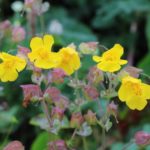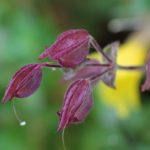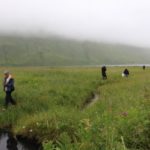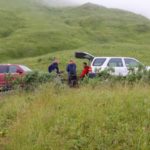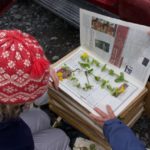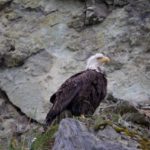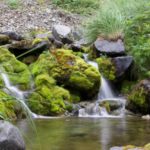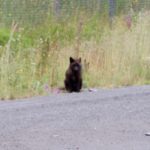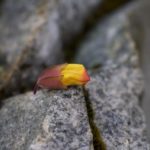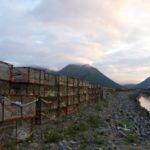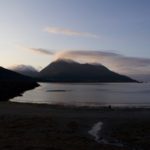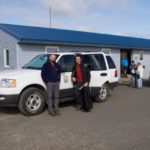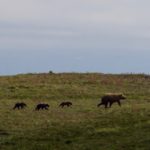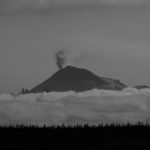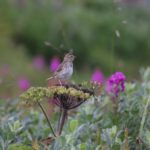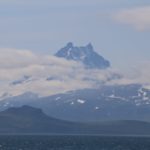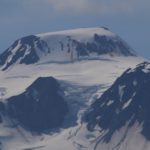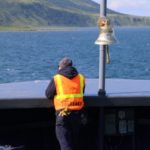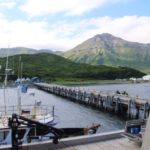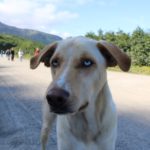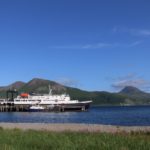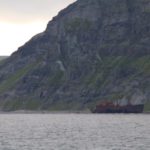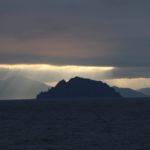Talking with a friend about hiking in Alaska and realized I'd never posted this particular day of the mimulus adventure. Words are excerpted from a forthcoming story of same. #natgeo #expedition #AleutianHiking #botanizing https://t.co/NAJWFnqXxQ pic.twitter.com/mynzHKkyvm
— Roger Topp (@rmtopp) July 31, 2018
Category: Uncategorized
Going Home
10-11 August 2016.
I spent today looking for flowers and driving back to Anchorage. I found a couple more populations, and stopped for a large pizza on a restaurant by the road. It tasted delicious! On the way I stopped in the Kenai River, and in some smaller tributaries. The creeks were full with sockeye salmon. In those places of easy access, fishermen were having a field day. I wondered if intense fishing competes with wildlife that relies in the salmon runs. The fishing of salmon in Alaska I supposed to be regulated, but I suspect the fishing quotas are seldom enforced. There are too many fishermen and too few park rangers.
Now I am at the airport, waiting for my last connection back to Scotland. I am excited to go back to my family, and can’t wait to see my wife and two-year old after three weeks away.
The trip has been amazing. I learned lots, met great people, and saw monkeyflowers in their natural habitat for the first time. Alaska has captured my imagination once again. And the Aleutians have been as exciting as I expected and more. Now the second part of the project can begin. Using thousands of genetic markers we will attempt the first world-wide analysis of monkeyflowers. The samples we collected in the Aleutians and the rest of Alaska will be studied alongside with other samples from western North America, Europe, the Faroes and New Zealand. We hope our study will help understanding how species adapt to new environments, and throw some light into the origins of a little yellow-flowered plant that was collected more than 200 years ago in a Russian expedition to Alaska.
The Kenai Peninsula
9 August 2016.
I woke up at 5:00am to pick up camp and drive to the ferry terminal in Valdez. The ferry took me across Prince William Sound to the port of Whittier. In the sound I saw my first orca whale! The fog and cloud accompanied us most of the way.
Whittier is a strange place built in secret by the army in WWII. The only way out of the port by road is through a long tunnel through the heart of the mountain. The single lane tunnel changes direction every half hour to allow traffic both ways. Coming out of the tunnel I was received by Portage Glacier and finally some clear and sunny skies.
Near one of the mountain passes, within the Chuchach National Forest I found more Mimulus, again different from what I saw in Valdez. I kept driving into Kenai with the aim of reaching Homer that night. It was a good drive with lots of mountains, glaciers and the incredible Kenai River full of salmon fishermen. Around 8pm I reached Homer in clear skies. The port town is framed by snowy mountains and glaciers. In the spit, an eclectic mix of people and wildlife hung out together. A couple came out of a grounded boat turned into a house. The beach was full with RVs and tents. Near the shore, some seals or sea lions hung out not far from the fisherman on the other side of the spit. This is my last night in Alaska.
Back On Track
8 August 2016.
After two days searching I found Mimulus today. Along a salmon stream a few plants poked their fruity and flowery heads through the grass. A couple of people were mesmerized by seeing the salmon swim upstream to find a place to lay their eggs, but I was too excited to find monkeyflowers here. The National Park ranger (Bonnie) looked at me amused and happy to have helped to find the plant.
There were only a few plants, but they were enough for spurring me into keep looking. About 20 miles from Valdez I found more plants and up the road a few more. Success!
As I was pulling out from one of the sampling sites I noticed a tire had gone completely flat. I changed the tire on the side of the road and found a metal hook deep into the broken tire. A few hours later I had driven back to Valdez and repaired the tire. I collected a few more populations at increasing elevation. These plants are different to the other ones we have seen in the trip. There is a most interesting phenotype here that I have not seen anywhere else. I’ll have to look more carefully at these plants when I get back to Scotland.
The Accident
7 August 2016.
Today I drive from Glenallen to Chitina. Chitina is the gateway to the Wrangell-St. Elias National Park. The park is enormous: the size of Switzerland or about several Yellowstones. It is also one of the coldest places on Earth. But is an amazing region, beautiful and remote. I barely scratch the surface as venturing into the park is an adventure on its own, and not something that could be attempted fully in a couple of days. One of the park guards tells me about a pilot who has been flying over the park for 20 years and reckons he only knows about a fifth of it.
After Chitina the highway becomes a gravel road. The park guard at Chitina suggests not to attempt it without a full-sized spare tire. The rental doesn’t have one (just a small tire version which they call a donut). Apparently the main risk of driving there is not potholes, but into the rusty rails that were left behind when they converted the old rail line into a road. Being there I cannot resist, and decide to drive anyway. I just need to get into the park itself. The weather looks foul, and after 15 miles I reach an old bridge crossing an enormous gorge. The Kuskulana Bridge was built in 1910 to allow trains to transport the mineral riches extracted from the Kennicott and McCarthy Mines, sixty miles from Chitina. It takes me a long time to get to the bridge as the roads are rough, and I am wary of not puncturing a tire. Along the way I see a red fox, an eagle, and some ptarmigans. The place is amazing!
But instead of camping in the Park, I decide to aim for Valdez where I need to catch a ferry on the 9th.
On the road I see a very terrible accident that happened just ahead of me. I see a cloud of smoke raise in the curve ahead, and as I turn, I see the crash between an RV and a tourist bus. The RV is in the middle of the road, but the bus has gone on to smash on a hill on the roadside. People are badly hurt and I stop to help. Some people are jumping out of the windows of the bus. The RV has the front destroyed and the people there are still trapped inside. A dog in the front seat howls. It makes me terribly sad but I cannot do much. The police arrive soon after and I leave. I thinkk of the poor people and their families that are ending their Alaskan trip in such a way. I’m sorry for them.
I continue driving towards Valdez, and in the evening I see Whorthington glacier and approach it to almost touch it. The glacier is dreary in the cold rain, yet beautiful. The ice of a glacier seems to always shine of a special blue colour. Then I drive through Thompson Pass, and can almost see the peaks of the mountains behind the thick fog and cloud. In Valdez, the city has been completely covered with fog. But now and then I glimpse the Valdez glacier and the amazing mountains. It is rainy and cold. And for the second day I have not seen any monkeyflowers. As this bleak day ends, I set up my camp near the glacier.
6 August 2016.
The 6th of August was our last day in Unalaska. Jannice and I managed to resample one of the populations (UNA) to get the seed that was unripe when we saw it in the first day. It was a rush through the Overland Pass to Summer Bay in a cold and foggy morning. We found a few plants with seed and headed back to the hotel to check out and pick up Josh. The small plane at the airport arrived soon before our departure, exchanging passengers between Anchorage and Dutch Harbor.
At Anchorage we part ways. Jannice and Josh head back home, and I will stay a few more days to try sampling monkeyflowers in mainland Alaska. These populations will be useful as markers to compare against the monkeyflowers of the islands (Kodiak and the Aleutians) and Alaskan Peninsula. If our hunch is correct, the Scottish monkeyflowers should group closer to the Aleutian and Kodiak samples than to the ones I hope to find in mainland Alaska. But finding Mimulus in mainland Alaska is harder. They may not be as common as in the coast and islands further west.
After picking up a rental SUV I drive for a few hours east on the Glenn Highway. After passing the town of Palmer two mountain ranges rise up: the coastal mountains in the south and the interior mountains in the north. The road follows more or less the Matansuka River, and soon I read the glacier of the same name. The landscape is impressive. Unlike treeless Unalaska, the mountains here are forested. The glacier snakes down the valley reaching the river plain. Soon after a new range of mountains rises up in the north. These mountains are made of gypsum, coloured red in the evening light. The gypsum of these red mountains is witness of the volcanic activity that shapes Alaska. Around eight or nine in the evening I decided to stop and set camp. I find a campsite in Glenallen, a small roadside town that has few attractions except its beautiful surroundings. I fall asleep among the sound or rain and strong winds. For the next days, Alaska has decided to release some wet and rough weather to make the monkeyflower search more interesting.
Dutch Harbor

2, 3 August 2016.
I am having breakfast looking out of the hotel window. About 100m from here a seaplane sits in the calm waters, waiting to be sprung into action. The seaplane is a herring spotter, used by fishermen to help them locate schools of fish while at sea. Fishing in the Aleutians needs diverse strategies.
The second of August was a relaxed day. In the morning we picked up camp and came back to Unalaska. The weather was wet and a bit windy, and the chill slowed us down a bit. When we were ready to go it was too late to attempt a long hike given the weather conditions. Instead, we decided to explore the World War II embattlements in Mount Ballyhoo. Ballyhoo lies behind Dutch Harbor. The conical mountain that we climbed the first day is also the place where the Americans hurriedly built military defenses to protect Unalaska. After the bombing of Unalaska, local people were evacuated to the mainland, and the only residents left here were soldiers, digging trenches, building bunkers, and mounting guns and cannons into the cliffs overlooking the bay of Unalaska. When the locals were evacuated by the army they were not allowed to transport more than what they could carry in a small suitcase. When they were allowed to return years later, people have lost much, their houses and churches emptied and ransacked by opportunists. Today what remains of that dark time are the abandoned war buildings that spill in all directions into the island.
In the bunkers in the cliffs of Ballyhoo, the concrete walls were covered by the graffiti of subsequent visitors. The doors were broken and fallen, or gone altogether. Cables hung from the flat roofs, and a few structures collapsed under the weight of the earth used to hide them from Japanese attacks.
In the gray and rainy day, the place had an eerie feeling to it, and we walked among the ruins in silence.
Among the cracked walls and floors, I found a very special plant: Arabidopsis kamchatica. Arabidopsis kamchatica is related to the model plant species thalecress (A. thaliana), and has a complicated family history. A. kamchatica originated through hybridization between two species, followed by one of the most significant mutations in nature: the doubling of the entire amount of DNA in their cells, a phenomenon called polyploidisation. Genome doubling, or polyploidy, has had a massive influence in the evolutionary history of plants, and it is one of the topics I study in my lab. It is the same process that produced the Scottish monkeyflower I discovered a few years ago (Mimulus peregrinus). I was glad to see a more ancient polyploid, A. kamchatica, growing in Unalaska. Labs around the world, including Diana Wolf’s in Fairbanks and Kentaro Shimizu in Zurich, have been studying this little plant for years. I hope to be able to help their research projects with our observations and collections of A. kamchatika in the Aleutians.
On the 3rd of August, we explored Peace of Mind Trail, which reaches Beaver Inlet, one cove away from Ugadaga Bay. It was a great hike. We collected Mimulus in waterfalls and lakes. When we reached the beach, an inquisitive red fox watched us from the rocks on the beach. We had lunch on a log brought to the sand by the ocean drift. A young bald eagle kept jealous watch on us, wondering why had we taken her favourite spot. In the afternoon, we met Suzi for dinner. We exchanged stories, and ate fresh seafood brought by the fishermen of Dutch Harbor.
Exploring Unalaska
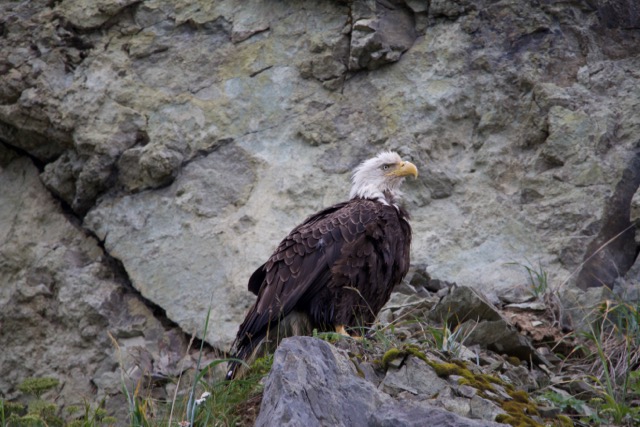
We started exploring Unalaska in the company of local naturalist Suzi Golodoff. Suzi knows plants and pretty much anything to do with Unalaska and her company made this first day of exploration both fun and extremely useful.
The day was overcast, and the clouds covered the mountain tops. After getting land use permits from the Unalaska Native Corporation we drove and hiked around the island. There is much to say about all the places and plants we saw, and little time to do it. So I will keep it short, and just explain it as captions to some photos.
The bottom line is that we have found Mimulus in Unalaska!
This plant is extremely common and occurs in a variety of habitats from rocky cliffs, to bogs, to hot springs.
There seems to be two main types of Mimulus, although we do not know for sure how much of this is genetic variation or the plastic response of plants to their local environments. All plants seem to be relatively large, robust, and clonal. The two types we have documented are, first, plants with red calyces (the usually green part of the flower that surrounds the yellow corolla) and with a faint red mark in the back of the petals at the tip, and, second, plants with green calyces, and no obvious red markings in the petal tips. There is no obvious separation in habitats between the two types, and the distinction may become blurred in some populations.
Unalaska has been fantastic to us. Full of monkeyflowers, and great plants. And also wonderful wildlife including whales, sea otters, bald eagles, foxes, ravens, puffins, salmon runs, king fishers, and many more.
The town of Unalaska is also extremely interesting. A certain type of marine wild west. A frontier town that feels like a recently established village, despite the fact that humans have lived here for 9,000 years.
Arriving to Unalaska
The alarm went off while the cabin was still pitch dark. We had twenty minutes to get ready for sampling in the last stop of the ferry before reaching Unalaska. When the ship landed in Akutan the lights of trucks and floodlights around the harbour gave us a faint idea of how this island looked like. We had read the eastern Aleutians.
Three figures with headlamps raced away from the ferry as soon as the ramp was set, while everybody else remained on deck or greeting passengers at the harbour. We split into two groups to cover more ground, and I quickly found Mimulus growing along a small creek or burn that came down the mountain, near the helicopter pad. With nor landing strip for plans, the helipad is the only aerial link for Akutan’s few residents. On the way back I got chatting with the bartender of Akutan that was travelling to Unalaska for a weekend outing. He told me many stories of living there, hunting, and the difficult and often solitary live he endured. The stories I heard would make a post on their own, but I will save them for later as we are about to leave.
—
We arrived in Dutch Harbor around 10am. As we came into the bay we saw a whale so close that you felt you could touch it. From the approach we could see Unalaskan Orthodox Cathedral, the iconic building that has come to be a synonym with this town.
We picked up the rental SUV and stopped for lunch at the Cathedral. We ate as a bald eagle kept watch on us from the highest cross of the church. This place has so many bald eagles, it is unbelievable. Later we learned from an excellent naturalist that in one Christmas census, the townspeople recorded 800!
In the afternoon, we met Steffi Ickert-Bond and Roger Topp from the Museum of the North and the University of Alaska, Fairbanks. The following day we would meet Suzi Golodoff, and with her the Langsdorff expedition would be complete.
After meeting with Roger and Steffi, we decided to hike up Balyhoo, the pointy mountain overlooking Dutch Harbor. The steep ascent rewarded us with botanical prizes including a swan orchid, dwarf rhododendron, and a myriad of other wild flowers. At the top, we had a clear view of the bays of Unalaska, Iluliuk, and Capitains, as well as Hog island. Eagles and ravens circled and passed near us. The precipitous cliff on the other side was not enough to deter Jannice from sampling dwarf rhododendron for Steffi.
After the hike, we checked in the Grand Aleutian, probably the only hotel in town. We met a team of volcanologist travelling by helicopter to sample ash. It is easy to spot scientists here. The plastic bags full of samples, permanent markers in hand, and GPS devices. But most of all by the faces radiating a mix of exhaustion and excitement, and the thrill of exploring a beautifully remote land.
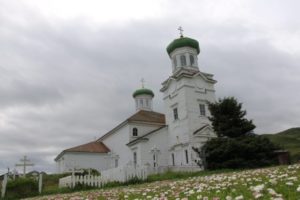
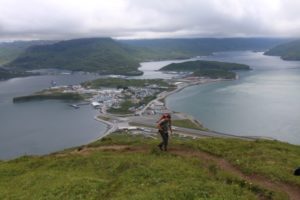
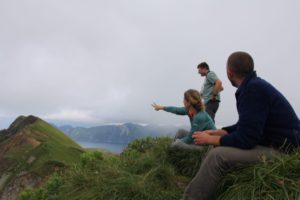
Smokey Volcanoes (Pavlov)

29 July 2016.
The day started early as the first port of cold was King Cove at 7:15am. King Cove is a small port surrounded by smooth conical peaks. The early sun painted the lenticular clouds above the summit, and the Tustumena landed in the shade of these gigantic mountains. This was a short stop, barely over half an hour. I asked one of the local crew members on the dock if they had seen monkeyflowers. “Yes, it is everywhere”, answered a girl about 20 that was securing the ferry with heavy ropes. “Where could I find the nearest ones?” I asked. It was hard for her to decide: “Go right, no, perhaps left, there are very many.” Lo and behold we found monkeyflowers in a yard to the left, where the fishermen kept crab traps and other gear. Strangely, Mimulus was growing on the dry ground away from a stream or an obvious water source. The soil, though, showed that at some point this area is flooded, and the drought is only transitory. We found many small plants, with lots of seeds. I picked a few plants for herbarium records. I walked a bit further, towards a sandy beach and I surprised a red fox searching for food on the edge of the water. Startled, the fox ran into the vegetation as I fruitlessly shot my camera to get some blurry pictures of a red dash. King Cove have given us a treasure of Mimulus, in about 20 minutes. Not a bad way to start the day.
The next stop was Cold Bay at around 11am. This is one of the most exciting stops of the trip, as it is here where the headquarters of Izembek National refuge is. On the ship we had met the new manager of the Refuge, who was travelling with his two dogs. Traditionally, the ferry holds a lottery to choose 20 lucky passengers that are then taken on a 2 hour tour of the Reserve. Josh and I were lucky enough to go, while Jannice had to stay behind picking cloudberries.
The tour was fantastic. We learned about this last frontier of US land conservation. A big reserve set to protect eelgrass, which feeds thousands of migratory birds including Brent goose who arrive here every year after migrating from Baja California. About 2km into the reserve, a passenger shouted “Bear!” and our truck slid into a halt. While everybody looked for the (non-exisitent bear) I spotted monkeyflowers on a stream. Unfortunately I was not allowed to stop to collect so I could only mark the site with my GPS while we drove away. But our spirits were lifted when barely 1km away we did spot a brown bear. A large female bear rose from a low hill, followed by three cubs. The wind carried our scent and she stopped and looked, then ran a few dozen meters leaving the cubs to hurriedly catch up. Then she ran and stopped again, playing this game, while keeping an eye on us, until they reached a lake. It was a great sighting of this bear family. We continued with the tour of the refuge, hearing the story of the place, people and wildlife.
A definite highlight was to see the four volcanoes poking their head out from the clouds. Seeing these volcanoes is not assured in a short stop in Cold Bay. The ever present clouds is the very reason why the US military chose this site for a base during the warm up to the Second World War, hoping that they could hind military structures from the Japanese bombers.
The most interesting volcano was Pavlov, which was smoking, producing a thin flume that raised up far in the sky. Seeing a smoking volcano here was among the list of things I really wanted to see. After all we are sailing in the Ring of Fire, and an active volcano makes justice to this awesome name.
We eventually came back to the ferry a bit late, just to find that Jannice had fished a fairly good-sized fish with a borrowed rod that a kid and his dad take out at every stop. Oh, and I was forgetting, that when we arrived to Cold Bay we were also received by the locals, but this time two entrepreneurial kids were selling Japanese glass bubbles. These beautiful bubbles wash now and then in Alaskan beaches. They were used by Japanese fishermen to keep their nets afloat, and sometimes were lost or thrown overboard. Now replaced by plastic floaters, these glass bubbles are not only of historical interest but also extremely beautiful.
Next stop was False Bay. As we approached we kept an eye for wildlife. There were hundreds of tufted puffins floating on swirls at the mouth of the bay. Josh and Jannice also say a bear and cubs. At port, we had a bit more than an hour and a half, and within a few minutes we found monkeyflowers on the side of the road. It was a successful stop into this small community with population of 54. At the end of the pier there was a bunch of entrepreneurial kids selling lemonade, banana loaf, and glass bubbles. I couldn’t resist and bought another bubble, this time still surrounded by the original net. And banana loaf which I am having with tea in my little homage to Gillian and Lucia back home in Scotland.
After dinner I sat in the front deck near the bow of the ship. The Captain pointed out the wreckage of the Oduna, a ship that sunk at the coast in 1965. The rusting hull lay inclined against the rock cliffs. The sunset was ferocious, with low cloud acting as a lid that touched the tops of the conical volcanos and jagged mountains. In a curious natural phenomenon, a hole pierced the cloud just above a lonely island, and showered the bare rock with light. In the background, what at first looked like clouds, turned out to be a massive mountain range with snow covered peaks, and even higher than the volcanos of the background. At 10:30pm a pod of eight whales passed on both sides of the ship. The ship rocks softly, and the sun refuses to abandon the mountain peaks.
